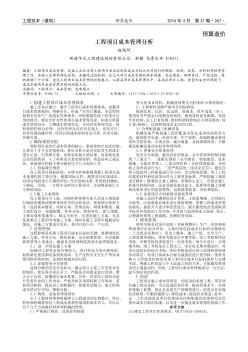At present, our country is in the largest and fastest process of urbanization in the history of mankind. “Engineering”, as an important foundation for urbanization, and “Humanity”, the core for urbanization, they attract increasingly attention. Nowadays there are so many professional works in the field of “Engineering” and “Humanity”, but rare combined works of these two parts, let alone analyze “Engineering and Humanity” in simple terms with the combination of theory and practice as an engineering practitioner. In this sense, Analysis on Engineering and Humanity written by Professor Lu Guiqing is evidently rare treasures.
Engineering is the concrete reflection of human creation. The creation of engineering activities not simply presents an activity for material production but contains the spirit of humanism. Engineering activity needs to choose, combine and integrate both all material and technical factors and all humanistic factors. Humanity is an intrinsic attribute that cannot be ignored. Engineering should “serve for the people”. Every so-called engineering effort which values “materialism” and despises “humanity”, stresses “presentation” and ignores “connotation”, pursues “minor details” and abandons “major parts” violates the essence of “serve the people” in engineering, which can be regarded as the loss of humanism spirits. In this book, based on “Engineering” as the basic point and “Humanity” as the core, the author comprehensively and systematically combs related engineering historical and cultural context, abstracts spirit of “humanity” in the “Engineering”, analyzes the loss of humanism spirits and its causes in the process of urbanization, thus improving the thinking to the height of “Chinese Urbanization should ‘serve for people’ ”.
Nowadays urbanization facing a critical time of transformation, based on which the author put forward his thinking that the relationship between “engineering” and “human” should be accurately dealt with to meet the essential requirement of “better city, better life”. This accurately grasps the pulse of the times and conforms to the historical trend.
According to the author’s opinion, man is both the “user” and the “builder” of engineering; while engineering “depends on man” and is also “made for man”; thus both the construction outcome and its process of engineering should reflect the concept of people-orientation. Then people’s active role in the engineering construction can be protruded. At present, during the process of urbanization construction, the main attention goes on the economic boom but not on the organic inheritance of history and culture, on the expansion of city scale but not on the protection of the ecological environment, on the urban material life but not on the spiritual civilization. Facing such “humanity lost”, the author calls on that as a citizen, especially as a engineering participant, people should make some changes and take some measures instead of being insensitive to leave those problems unchecked. The author, a leader of large state-owned construction enterprise, based on his hands-on practice, summarizes the beneficial exploration and original experience of his own enterprise and other organizations that adhere to humanistic orientation in the process of engineering construction; he also rigidly points out the causes of “illness” and prescribes the “medicine” to it, sincerely hoping that the whole society can be alerted to the problem of “humanity lost” in the process of urbanization construction and can feel awesome to nature, history and humanity, hoping people’s demands of “humanity” of urbanization can be high-lightened and recovered. This not only reflects the author’s comprehensive understanding and deep insights of the engineering essence, but also reflects the spirit, courage, responsibility of the leaders’ in the modern construction industry. The sense of his mission to the nature, culture and livelihood is quite admirable.
This book, with vivid examples, specific analysis and clear logic, is easy to understand. It is valuable in the study of urbanization from the aspect of humanities and social science. Owing to its great value in academy, actual practice, theory and application, the book is available for government policymakers, academic researchers, especially the workers in construction enterprises for the application of humanistic practice.
Lu Guiqing, who is always in the forefront of the engineering construction, has the qualities of erudition, query, deliberation, and thoughtfulness. After all, he is a great contributor in the reform of state-owned enterprises. Being the main chief of China Construction Fifth Engineering Bureau since 2002, he has turned the troubled enterprise into a brand new one. In the past 11 years, the scale of operation increases from over 2 billion to over 130 billion, and the general assets increases from over 2 billion to over 40 billion. Generally speaking, the profit of enterprise transfers from a loss situation to 2.5 billion and the average income of the works increases over 20%. Achieving a sustained, rapid, scientific development, the enterprise’s economic indicator presents as 85 growth curve which is commended as “The Phenomenon of China Construction Fifth Engineering Bureau” by the field of the press, the theorists and the enterprises. Lu Guiqing makes a great contribution to the management innovation. The people in the field of construction and other fields speak highly of his works, like “The Dujiangyan Triangle Rule”, “square-circle map of engineering project cost management”, Analysis on Scentific Management of Construction Engineering Enterprise, and the Faith·Harmony Manual etc. The book, Analysis on Engineering and Humanity not only presents his thoughts but also show his sympathy to the world and his courage to be pioneer
I respect him and admire what he has done, so I write the preface.
Zhang Jinqiu 2014-6

 工程项目成本管理分析
工程项目成本管理分析

 工程项目成本管理初探
工程项目成本管理初探